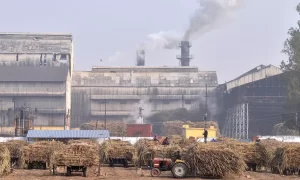SRA: Increased acidity seen in Negros sugarcane plantations

The Sugar Regulatory Administration (SRA) detected increased acidity in sugarcane leaves and soil on Negros Island after Kanlaon Volcano’s ashfall. pH levels dropped to 4.14 in leaves and 5.06 in soil, compared to 6.48 the previous week. SRA warned of potential long-term soil rejuvenation needs and immediate crop damage but noted benefits from ash’s nutrient richness. 23,000 hectares might be affected. Farmers are advised to irrigate and apply lime.
The Sugar Regulatory Administration (SRA) has detected increased acidity in sugarcane leaves and ground soil in certain areas of Negros Island following the ashfall from the eruption of Kanlaon Volcano on Monday.
In a statement released on Wednesday, the SRA reported that the potential hydrogen (pH) levels showed a 4.14 pH in sugarcane leaves and a 5.06 pH in the soil the morning after the ashfall. According to the agency, these readings indicated increased acidity compared to the 6.48 pH recorded in the ground tested just the previous week.
“The pH level of 7 is neutral, but years of tilling sugar fields have affected our soil, and the 6.48 pH result last week should have been ideal. With the current results after the ashfall, if this acidity is not washed out by rains, we will require soil rejuvenation in affected sugar lands to return it to its ideal state, and that is a long-term process,” SRA Administrator Pablo Luis Azcona explained.
However, Azcona cautioned that it is still too early to ascertain the damage the volcanic ash may cause to crops, noting that there have been rains in the affected areas, which could dilute the acidity.
Additionally, SRA’s research and development arm reported that the immediate effects of volcanic ash might physically damage sugarcane leaves, reducing their photosynthesis capability, and disrupting the biological and chemical balance in the soil, potentially leading to a decline in harvest.
“The long-term effects on sugar crops could include nutrient imbalance in the soil, compaction, erosion, and chemical leaching, which may reduce the soil pH level,” their statement read, indicating that approximately 23,000 hectares across four sugar mill districts might be affected by the volcanic eruption.
Therefore, the Department of Agriculture advises sugar farmers, in the event of continued ashfall, to protect crops, irrigate by washing off plants and soil, and apply lime or organic matter to neutralize changes in soil pH.
Nevertheless, SRA highlighted that sugar growers could benefit “in due time” from volcanic ashfall due to its richness in minerals and nutrients, such as potassium, phosphorus, and trace elements, which can enhance soil fertility and improve crop yields.
“The fine particles in volcanic ash can also enhance soil texture and water retention, promoting root growth and reducing the need for frequent irrigation. Additionally, it can act as a natural pesticide by creating a physical barrier against pests and disrupting their life cycles, thus reducing the need for chemical interventions,” the statement added.
Source Link: https://tribune.net.ph/2024/06/05/sra-increased-acidity-seen-in-negros-sugarcane-plantations-2

















